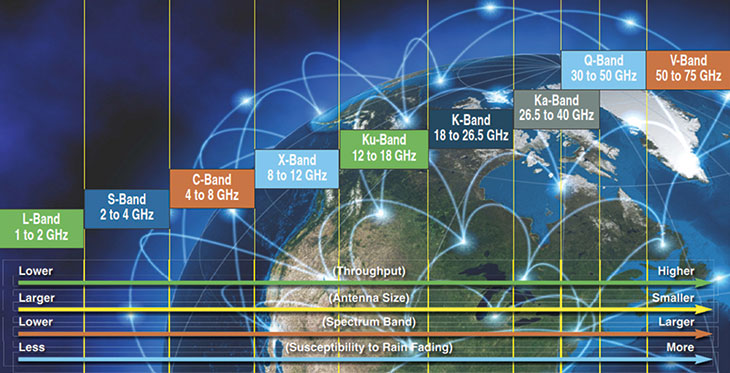
Antennas need to reflect the world around them. And that increasingly is multi-constellation, multi-orbit, multi-beam, multi-band.
Constellations spoke with Bill Milroy, Chairman and CTO of ThinKom, a developer of antenna systems, on the rapid change in space and satellites, and the challenge for a new generation of antennas, such as phased arrays, to support the need for connectivity in an increasingly diverse spectrum environment.
Milroy said the increase in the variety of orbits and constellations has created a push for an antenna that can work on a variety of systems, with terminals that are able to work towards “interoperability on different frequency bands, different orbits and different types of constellations.”
The industry as a whole, he said, is doing a good job in terms of leading interoperability.
Milroy broke down the “multi-constellation, multi-orbit, multi-beam, multi-band” qualifier, explaining that antennas need to be able to work on not just one constellation or one owned satellite, but ideally on everyone's.
For multi-orbit, to move from GEOs, to MEOs, to LEOs because the future is not “either or GSO or NGSO.”
For multi-beam, to preferably create more than one beam, with a beam on a GEO and a beam on a LEO satellite, or beams on two different LEO satellites as examples.
And multi-band, because the unabated appetite for data means extending into higher frequency bands, which he expects to be added in the near future because “that’s the way the market is evolving,” he said.
“We started at Ku, we’re now adding Ka…and we see the market going in the direction to moving or adding other bands like Q and V,” he added.
 Higher frequency satcom bands provide greater spectrum allocation. (Source: Comtech Xicom Technology)
Higher frequency satcom bands provide greater spectrum allocation. (Source: Comtech Xicom Technology)
One Size Fits All?
Yet, with all those demands, is there one antenna to rule all, or to cover all those needs or frequencies?
“Yes, but at what cost and what practicality?” he answered. He said that Ka and Ku are two very popular frequencies,” but it’s harder to make the argument that you really need to do both because “you have such rich multiple constellations, multiple suppliers, multiple orbits that are going to work in either band.”
Doing so would add more equipment, weight, and cost making it more difficult to make the argument “that you need to do all the bands at the same time.”
But there are cases, he added, where it will make sense to move to other frequency bands, and to have a hybrid antenna for example that works in Ku or Ka, but that also does Q and V band.
“It’s going to start to become important to do at least two bands. That’s going to have utility going forward,” adding in jest that, “they say you can never be too rich, too thin, or have too much bandwidth.”
Different Flavors
Milroy cited several innovations driving new antennas, one being phased arrays, which he characterized as generally anything that’s not a parabolic dish. These, he said, come in “different flavors,” from a panel mechanically moved by motors to point in different directions, to a definition narrowing down to electronically scanned arrays.
Like ground virtualization, these antennas are also becoming more software-defined, with antenna hardware that can be reconfigured to work on different systems using software.
That software-defined capability, he said, supports the move to multi-constellations, the ability to move back and forth between LEO, MEO, and GEO satellites that each have their own modem and software requirements.
One Plus One Equals Five
In addition to LEO capable systems that can move a beam quickly across satellites, the next step, Milroy explained, was the fusion of orbits to work on a LEO and a GEO satellite at the same time. That benefit would allow operators to ‘shape’ their IP traffic and coverage based on latency or other user needs.
“This is a ‘one plus one equals five’ kind of solution,” he added. That’s where I think the market is moving to in terms of not GSO only or NGSO only, but doing those two simultaneously, fusing them together, and providing a much better net experience for the user.”
Another software-defined attribute was the ability to scale to multiple beams. A parabolic dish can cover multiple bands, but it can only service one satellite at a time, a constraint given the exponential growth in the number of satellite beams for ground station gateways to service.
“If you have five X the number of beams and have to buy five X as many dishes, there’s a whole lot of reasons that that’s not considered to be a viable way to scale your system.”
A reconfigurable phased array-based system on the other hand, he explained, can mimic a large parabolic dish to make a link to a small satellite at low elevation. And when it’s not doing that, “it can create four beams, eight beams, 16 beams to service a much larger number of satellites.”
That he said, is resonating with ground station customers and the satellite constellations that depend on the ground stations.
The Yin & Yang of Open & Closed
With all the change afoot, including with acquisition and consolidation, Milroy was asked if the move would be to more proprietary approaches, with everything integrated from the ground station to the satellite to the user terminals, or to more open systems? He said there was a bit of a” yin and a yang in the marketplace,” with a stove-piped proprietary approach having some advantage from a constellation or supplier standpoint, but that customers generally want to pull in the other direction.
“Customers want to buy one terminal that can work on multi-constellation, multi-orbit, and multi-band.”
Using the (IFC) inflight connectivity market as an example, he said companies like Boeing and Airbus and the airlines themselves, want an agnostic system, an antenna they can put on the plane “with the idea it’s future proof and agnostic and can work on all the different constellations.” And to that, “we say viva la difference.”
Military Logic
Similar logic is also taking hold in the military, which is challenged with a broad range of applications and terminals. As an example, he cited the NGTT, the next generation tactical terminal. ‘The Army vision is to take that agnostic type of antenna system I described and apply that to the Army.”
The trick, he said, is to have all those agnostic features so it can work with any network, but at a cost point that it can be deployed inexpensively and affordably as a solution “on lots and lots of vehicles.”
“In the NGTT terminal, the Army is requesting to be able to do all constellations,” he said, meaning that they want to work on Ku and Ka band, all GEO constellations, commercial and military, and all LEO constellations, commercial and military.
“They’ve thrown down the gauntlet, that the reward if you can do this is they anticipate you would be able to sell thousands and thousands of terminals. That is a big opportunity.”
The Future (proof) Antenna
While he reiterated that to be future proof, terminals “better be multi orbit, multi-constellation, perhaps multi-band and perhaps even multi-beam,” he cautioned, “there’s no free lunch,” and that there will be compromises on the size, weight, power and cost, or what’s known as SWAP-C.
For a system to do everything, “realistically it’s going to be a little bit bigger, it’s going to weigh a little bit more, it’s going to require more power, and it’s going to be a little more costly. So you have to choose.
“It’s not something you’d say, ‘I want all things, all the multi capabilities.’ You need to look into what works in your particular business model or for your particular needs.”
To hear more about the changing spectrum environment, advantages and trade-offs of new antenna capabilities and the future of satellite connectivity click here.
